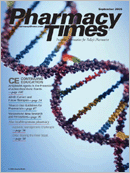Publication
Article
Pharmacy Times
Understanding an Important Variable in Patient Response
It is known that differences in the genetic makeup of drug-metabolizing enzymes (genotypes) can influence the outcome of drug therapy. These genetic differences are also responsible for some of the variability we see in patient responses to drug-drug interactions. The Table lists 3 common drugmetabolizing enzymes that are known to have different genotypes. When patients have normal genes coding for an enzyme, they are known as extensive metabolizers (EMs). If one or more genes for the enzyme are abnormal (mutant), this may reduce the activity of the enzyme and slow the metabolism of drugs that are substrates for the enzyme. Patients with abnormal genes that result in malfunctioning enzymes are referred to as poor metabolizers (PMs). Drug interactions caused by enzyme inhibitors cause a similar reduction in the metabolism of substrates for the inhibited enzyme.
Usually when a drug is administered, it is converted to inactive metabolites by enzymes. If the patient is a PM, the drug's clearance is reduced, and the drug will accumulate in the body, perhaps resulting in toxicity. Metoprolol is metabolized primarily by the enzyme cytochrome P-450 2D6 (CYP2D6). The clearance of metoprolol in EMs is about 5 to 6 times greater than in PMs. Thus, PMs of metoprolol are more likely to develop an adverse drug reaction (ADR). When a drug that inhibits CYP2D6 (eg, diphenhydramine [Benadryl]) is administered to an EM who is receiving metoprolol, the rapid metabolism of metoprolol will be markedly reduced. The resulting elevation of metoprolol plasma concentrations may potentially result in an ADR. If a patient receiving metoprolol is deficient in the CYP2D6 enzyme, the coadministration of diphenhydramine will have very little effect.1 This is because the PM patient has little or no CYP2D6 enzyme that can be inhibited by the diphenhydramine. Thus, the PM patient is actually less likely to experience an ADR from a drug interaction with a CYP2D6 inhibitor than an EM patient.
Codeine is a prodrug that is converted in vivo to the analgesic morphine by CYP2D6. Patients who are CYP2D6 PMs will not convert codeine to morphine and will have a reduced analgesic effect from codeine. When patients who are CYP2D6 EMs are administered a CYP2D6 inhibitor, they do not convert much codeine to morphine and have a minimal analgesic response to the codeine.2 In the case of codeine, administering a CYP2D6 inhibitor produces a similar outcome, as does the absence of the CYP2D6 enzyme. In both cases, a loss of analgesic effect is likely. Giving a patient who is a CYP2D6 PM a drug that is an inhibitor of CYP2D6 will not add to the reduced codeine metabolism produced by the genetic deficiency.
About 50% of lansoprazole's metabolism is via the CYP2C19 enzyme. PMs for CYP2C19 have plasma lansoprazole concentrations that are about 4 to 5 times higher than EMs.3 When lansoprazole was administered with tacrolimus, the mean tacrolimus concentrations increased >80% in the participants who were CYP2C19 PMs and <30% in the EMs.4 Tacrolimus is not considered to be a substrate for CYP2C19. The higher plasma concentrations of lansoprazole found in the PMs resulted in a greater magnitude interaction with tacrolimus than in the EMs who had much lower lansoprazole plasma concentrations. While the mechanism of this interaction is not certain, the lack of CYP2C19 metabolism increased the concentration of the precipitant drug (lansoprazole) and increased the magnitude of its effect on the object drug (tacrolimus).
Changes in drug-drug interaction outcomes can be influenced by a patient's genetics. Being genetically deficient in an enzyme may either protect the patient from an interaction or increase the magnitude of one. The influence of genetics on drug-drug interactions needs to be considered for any interaction that involves enzymes that are known to have variable expression based on a patient's genetic composition.
Drs. Horn and Hansten are both professors of pharmacy at the University of Washington School of Pharmacy. For an electronic version of this article, visit www.hanstenandhorn.com.
For a list of references, send a stamped, selfaddressed envelope to: References Department, Attn. A. Rybovic, Pharmacy Times, Ascend Media Healthcare, 103 College Road East, Princeton, NJ 08540; or send an e-mail request to: [email protected]

Newsletter
Stay informed on drug updates, treatment guidelines, and pharmacy practice trends—subscribe to Pharmacy Times for weekly clinical insights.






